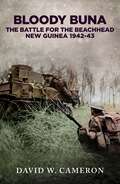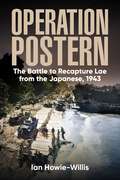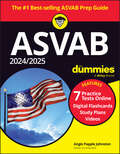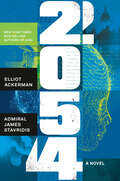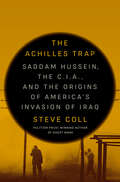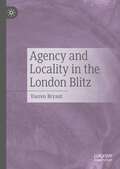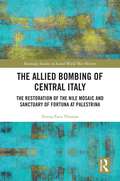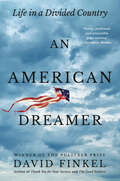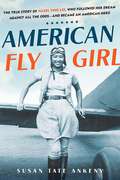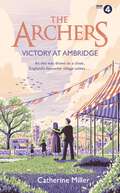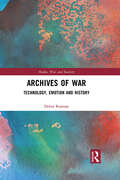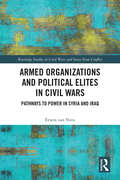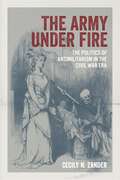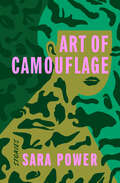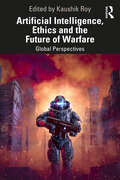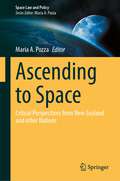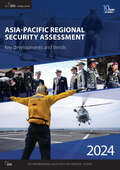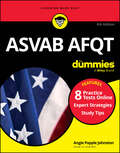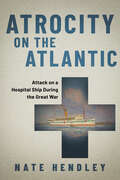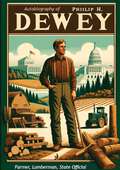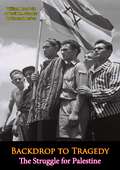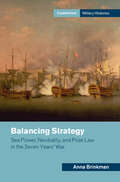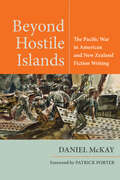- Table View
- List View
Bloody Buna: The Battle for the Beachhead New Guinea 1942
by David W. CameronWith the Australian troops crossing of the Kumusi River in mid-November, after pushing the Japanese back along the Kokoda Track, the time had come to face the entrenched Japanese at their beachhead at Gona, Sanananda and Buna. The end of the Kokoda Campaign in mid-November 1942 marked a turning point for the Australians, but the fighting was far from over. Within days, the battles for the three Japanese beachheads would commence. These battles where the first combined large-scale operation between Australian and American troops against the Japanese and would prove to be among the fiercest of the Pacific War. At Buna, the final battles to take 'New' and 'Old' air strips by the Australians, along with the ongoing American attacks to take the infamous 'Triangle,' proved to be a brutal and deadly bloodbath for all concerned. Amidst the crocodile-infested swamps and lowland jungle with dozens of Japanese bunkers and pillboxes with supporting artillery, the Australians who fought at all three beachheads faced an unprecedented toll, suffering more killed or wounded than in any other campaign of the Pacific war. In the face of relentless combat, the Allied forces at Buna suffered staggering casualties, with 2817 men lost at Buna. The American 32nd Division sustained 1954 casualties, including 353 killed (18%), 1508 wounded, and 93 missing amounting to around 40 per cent casualties over a six week period. The Australian 18th Infantry Brigade and supporting elements suffered 863 casualties, with 267 killed (31%), 557 wounded, and 39 missing amounting to around 60 per cent casualties over just three weeks of fighting. As the battle raged on, the Japanese suffered significant losses, with a minimum of 1390 men killed at Buna. The true number of their dead, lost in history, is likely much higher, with conservative estimates suggesting around 3000 fatalities. &“Bloody Buna" sheds light on the untold sacrifices and heroism displayed by the Australian and American troops as they clashed with the Japanese in one of the most vicious chapters of the Pacific War.
Operation Postern: The Battle to Recapture Lae from the Japanese, 1943
by Ian Howie-WillisJapanese troops seized and brutally occupied New Guinea&’s capital, Lae, for 18 months – until 16 September 1943. That day Australian soldiers retook the town against fierce resistance. Defeated, and after suffering huge losses, 8000 Japanese soldiers fled across the formidable 4000-metre mountains behind the town ; 2000 died on the nightmare trek.In a groundbreaking publication, independent professional historian Dr. Ian Howie-Willis unveils the untold story of 'Operation Postern' and its significant impact on the Pacific War. His latest book sheds light on the recapture of Lae, the capital of New Guinea, from Japanese forces on 16 September 1943. Through meticulous research, Dr. Howie-Willis brings to life the heroic efforts of Australian soldiers, the harrowing experiences of the Japanese retreat, and the often-overlooked plight of the Papua New Guinean village communities caught in the crossfire. Japanese troops had seized and ruthlessly occupied Lae for 18 months until the fateful day of the Australian soldiers' counteroffensive. Despite fierce resistance, the town was retaken, forcing the Japanese to retreat across treacherous 4000-meter mountains behind the area. Tragically, 2000 Japanese soldiers lost their lives during this nightmarish trek. Referred to as a turning point in the Pacific War, 'Operation Postern' shattered the Japanese belief that they could maintain control over the New Guinea mainland. Their continual retreat paved the way for subsequent successful Allied campaigns in the South-West Pacific theatre. However, victory came at a high cost, with over 2000 casualties within a fortnight for the Allies, while Japanese losses exceeded that number nearly fourfold. The exact toll on the Papua New Guinean village people remains unknown but undoubtedly significant. Dr. Howie-Willis challenges previous military histories that have marginalized the Papua New Guineans, highlighting their essential role as the "third party" to the conflict. By focusing on the village communities, he illuminates the horrific impact of the war on their lands and lives, offering a comprehensive and inclusive narrative. "Operation Postern" provides readers with an opportunity to revisit and reinterpret this crucial battle that shaped the course of history. Dr. Howie-Willis' extensive knowledge and meticulous attention to detail make this book a valuable contribution to the understanding of the Pacific War.
2024/2025 ASVAB For Dummies: Book + 7 Practice Tests + Flashcards + Videos Online
by Angie Papple JohnstonGet the score you need to get the job you want! The bestselling ASVAB For Dummies is back with an updated and expanded annual edition. This trusted study guide will help you succeed on the essential military recruitment test. Now with more examples, walk-throughs, and practice questions, you can land the score that will qualify you for your preferred military job. With practice tests in the book and online, videos, and hundreds of digital flashcards, this Dummies resource is perfect for all things ASVAB. Trusted by military recruiters across the country, this book also includes insider tips and tricks for test-day-success. Study at your own pace and make your dreams possible with ASVAB For Dummies. Learn from simple explanations of all the content covered on the ASVAB, plus tons of resources for studying Follow detailed study plans that will help you prepare 12 weeks, 6 weeks, 4 weeks, or 1 week before the test Take practice tests and work through detailed answer explanations to improve your score Get even more practice online, with practice tests, flashcards, and videos For years, ASVAB For Dummies has been helping recruits launch their military careers right. Now, it's your turn.
2054: A Novel
by Elliot Ackerman Admiral James StavridisFrom the acclaimed authors of the runaway New York Times bestseller 2034 comes another explosive work of speculative fiction set twenty years further in the future, at a moment when a radical leap forward in artificial intelligence combines with America&’s violent partisan divide to create an existential threat to the country, and the worldIt is twenty years after the catastrophic war between the United States and China that brought down the old American political order. A new party has emerged in the US, one that&’s held power for over a decade. Efforts to cement its grip have resulted in mounting violent resistance. The American president has control of the media, but he is beginning to lose control of the streets. Many fear he&’ll stop at nothing to remain in the White House. Suddenly, he collapses in the middle of an address to the nation. After an initial flurry of misinformation, the administration reluctantly announces his death. A cover-up ensues, conspiracy theories abound, and the country descends into a new type of civil war.A handful of elite actors from the worlds of computer science, intelligence, and business have a fairly good idea what happened. All signs point to a profound breakthrough in AI, of which the remote assassination of an American president is hardly the most game-changing ramification. The trail leads to an outpost in the Amazon rainforest, the last known whereabouts of the tech visionary who predicted this breakthrough. As some of the world&’s great powers, old and new, state and nonstate alike, struggle to outmaneuver one another in this new Great Game of scientific discovery, the outcome becomes entangled with the fate of American democracy.Combining a deep understanding of AI, biotech, and the possibility of a coming Singularity, along with their signature geopolitical sophistication, Elliot Ackerman and Admiral James Stavridis have once again written a visionary work. 2054 is a novel that reads like a thriller even as it demands that we consider the trajectory of our society and its potentially calamitous destination.
The Achilles Trap: Saddam Hussein, the C.I.A., and the Origins of America's Invasion of Iraq
by Steve Coll&“Excellent…A more intimate picture of the dictator&’s thinking about world politics, local power and his relationship to the United States than has been seen before.&” —The New York Times"Voluminously researched and compulsively readable." —Air MailFrom bestselling and Pulitzer Prize–winning author Steve Coll, the definitive story of the decades-long relationship between the United States and Saddam Hussein, and a deeply researched and news-breaking investigation into how human error, cultural miscommunication, and hubris led to one of the costliest geopolitical conflicts of our timeWhen the United States invaded Iraq in 2003, its message was clear: Iraq, under the control of strongman Saddam Hussein, possessed weapons of mass destruction that, if left unchecked, posed grave danger to the world. But when no WMDs were found, the United States and its allies were forced to examine the political and intelligence failures that had led to the invasion and the occupation, and the civil war that followed. One integral question has remained unsolved: Why had Saddam seemingly sacrificed his long reign in power by giving the false impression that he had hidden stocks of dangerous weapons? The Achilles Trap masterfully untangles the people, ploys of power, and geopolitics that led to America&’s disastrous war with Iraq and, for the first time, details America&’s fundamental miscalculations during its decades-long relationship with Saddam Hussein. Beginning with Saddam&’s rise to power in 1979 and the birth of Iraq&’s secret nuclear weapons program, Steve Coll traces Saddam&’s motives by way of his inner circle. He brings to life the diplomats, scientists, family members, and generals who had no choice but to defer to their leader—a leader directly responsible for the deaths of hundreds of thousands of Iraqis, as well as the torture or imprisonment of hundreds of thousands more. This was a man whose reasoning was impossible to reduce to a simple explanation, and the CIA and successive presidential administrations failed to grasp critical nuances of his paranoia, resentments, and inconsistencies—even when the stakes were incredibly high.Calling on unpublished and underreported sources, interviews with surviving participants, and Saddam&’s own transcripts and audio files, Coll pulls together an incredibly comprehensive portrait of a man who was convinced the world was out to get him and acted accordingly. A work of great historical significance, The Achilles Trap is the definitive account of how corruptions of power, lies of diplomacy, and vanity—on both sides—led to avoidable errors of statecraft, ones that would enact immeasurable human suffering and forever change the political landscape as we know it.
Agency and Locality in the London Blitz
by Darren BryantThis book takes a fresh approach to the London Blitz by viewing this time through individual local boroughs of the metropolis. The term ‘London Blitz’ means that culturally we have become accustomed to understanding that the actual blitz experience was the same wherever in the capital one happened to be, despite some areas being hit more than others. This book illustrates how there were many London blitzes, not one, influenced by a myriad of metropolitan localities, and giving rise to an agency of locality that helped to shape the lived blitz experience. By walking through the streets of London, this book conducts a local area analysis, witnessing the blitz through six London localities, representative of the assorted administrative, economic, and socio-political variables prevalent in wartime London. Covering air raids alongside topics like the provision of shelters, homelessness, and communal feeding, it shows how any history of the London Blitz must acknowledge that it was an experience reflective of a varied metropolis.
The Allied Bombing of Central Italy: The Restoration of the Nile Mosaic and Sanctuary of Fortuna at Palestrina (Routledge Studies in Second World War History)
by Teresa Fava ThomasThe Allied Bombing of Central Italy examines the results of the Second World War Allied bombing campaign on Palestrina and Rome, Italy, and the long-term impact of the war on the mountainside town and on the Barberini family's art collection including the Nile Mosaic. It explores the history and cultural significance of Palestrina, its strategic setting, the recovery of the town, the restoration of the Nile Mosaic, which remains the largest Egyptian-style mosaic extant. A unique aspect of the destruction was that it uncovered a pagan temple, the Sanctuary of Fortuna. The bombing destroyed the homes built on its terraces but revealed the ancient structure buried beneath which had remained unseen for half a millennium. It took more than a decade for the mosaic to be restored and the Sanctuary of Fortuna established as a national archeological museum. The book explores the pressure by the Mussolini regime to control the Barberini family's art collection, the uses of cultural materials for propaganda purposes, the Allied use of airpower in the Italian theater of war, the postwar decision-making and recovery process. The book is one of the very few long-range studies of the war's impact on a single Italian town. It is suitable for academic seminars and an educated general audience.
An American Dreamer: Life in a Divided Country
by David FinkelA man navigates the deep divisions in America today and discovers that sometimes change can start by finding common ground with your neighbors in this immersive account by the Pulitzer Prize–winning author of Thank You for Your Service and The Good Soldiers.&“Finkel&’s account is poetic, profound, and irresistibly page-turning.&”—Geraldine Brooks, author of HorseAs this powerful book begins, Brent Cummings finds himself coping with the feeling that the country he loves is fracturing in front of his eyes. An Iraq war veteran, raised to believe in a vision of America that values fairness, honesty, and respect for others, Cummings is increasingly surprised by the behavior and beliefs of others, and engulfed by the fear, anger, and confusion that is sweeping through his beloved country as he tries to hold on to his values and his hope for America&’s future.David Finkel, known for his unique, in-depth reporting, spent fourteen years deep inside Brent Cummings&’s world to create this intimate and vivid portrait of a man&’s life, his work, family, community, his thoughts, and his quest for connection, as America becomes ever more divided. Cummings was one of the unforgettable figures in Finkel&’s The Good Soldiers, a book about which The New York Times stated, &“Finkel has made art out of a defining moment in history. You will be able to take this book down from the shelf years from now, and say: This is what happened. This is what it felt like.&”An American Dreamer illuminates, with the deepest empathy, the feelings and lives of many people in America today, and it is a brilliant chronicle of one person&’s everyday experiences of frustration, confusion, and hope.
American Flygirl
by Susan Tate AnkenyOne of WWII&’s most uniquely hidden figures, Hazel Ying Lee was the first Asian American woman to earn a pilot&’s license, join the WASPs, and fly for the United States military amid widespread anti-Asian sentiment and policies. Her singular story of patriotism, barrier breaking, and fearless sacrifice is told for the first time in full for readers of The Women with Silver Wings by Katherine Sharp Landdeck, A Woman of No Importance by Sonia Purnell, The Last Boat Out of Shanghai by Helen Zia, Facing the Mountain by Daniel James Brown and all Asian American, women&’s and WWII history books. In 1931, Hazel Ying Lee, a nineteen-year-old American daughter of Chinese immigrants, sat in on a friend&’s flight lesson. It changed her life. In less than a year, a girl with a wicked sense of humor, a newfound love of flying, and a tough can-do attitude earned her pilot&’s license and headed for China to help against invading Japanese forces. In time, Hazel would become the first Asian American to fly with the Women Airforce Service Pilots. As thrilling as it may have been, it wasn&’t easy. In America, Hazel felt the oppression and discrimination of the Chinese Exclusion Act. In China&’s field of male-dominated aviation she was dismissed for being a woman, and for being an American. But in service to her country, Hazel refused to be limited by gender, race, and impossible dreams. Frustrated but undeterred she forged ahead, married Clifford Louie, a devoted and unconventional husband who cheered his wife on, and gave her all for the cause achieving more in her short remarkable life than even she imagined possible. American Flygirl is the untold account of a spirited fighter and an indomitable hidden figure in American history. She broke every common belief about women. She challenged every social restriction to endure and to succeed. And against seemingly insurmountable obstacles, Hazel Ying Lee reached for the skies and made her mark as a universal and unsung hero whose time has come.
The Archers: perfect for all fans of The Archers
by Catherine MillerIts 1943 and the war continues on in Ambridge. But the minds of the villagers are focused a little closer to home… For many centuries, a local tradition has told of a mystic living in a hermit&’s cave just outside the village. Legend tells that she has hidden her prophecies around the area, but none have ever been found. When a visiting academic arrives in Ambridge, there for war work, but personally intrigued by the prophecies, he becomes determined to find out more. And as the prophesies are uncovered, it appears the mystic knows more than anyone could have predicted – and when they become personal and foretell the death of a local Ambridgian, the village is united in surprise. Meanwhile, the war will end and some will come home – and some never will. And those who do will find that life in Ambridge has been changed….
Archives of War: Technology, Emotion and History (Media, War and Security)
by Debra RamsayThis book offers a comparative analysis of British Army Unit War Diaries in the two World Wars, to reveal the role played by previously unnoticed technologies in shaping the archival records of war. Despite thriving scholarship on the history of war, the history of Operational Record Keeping in the British Army remains unexplored. Since World War I, the British Army has maintained daily records of its operations. These records, Unit War Diaries, are the first official draft of events on the battlefield. They are vital for the army’s operational effectiveness and fundamental to the histories of British conflict, yet the material history of their own production and development has been widely ignored. This book is the first to consider Unit War Diaries as mediated, material artefacts with their own history. Through a unique comparative analysis of the Unit War Diaries of the First and Second World Wars, this book uncovers the mediated processes involved in the practice of operational reporting and reveals how hidden technologies and ideologies have shaped the official record of warfare. Tracking the records into The National Archives in Kew, where they are now held, the book interrogates how they are re-presented and re-interpreted through the archive. It investigates how the individuals, institutions and technologies involved in the production and uses of unit diaries from battlefield to archive have influenced how modern war is understood and, more importantly, waged. This book will be of much interest to students of media and communication studies, military history, archive studies and British history.
Armed Organizations and Political Elites in Civil Wars: Pathways to Power in Syria and Iraq (Routledge Studies in Civil Wars and Intra-State Conflict)
by Erwin van VeenThis book analyses under what conditions, and with what developmental effects, armed organizations shift their ‘coercive profile’ during civil wars, with a focus on the recent conflicts in Syria and Iraq.The work begins with an operationalisation of the term ‘political settlement’, focusing on how power is organized in fragile and conflict-affected countries, and then uses this operationalization to analyse the political settlements of contemporary Syria and Iraq, including their breakdown and transformation during recent civil wars (of 2011-today in Syria and 2014-17 in Iraq). It subsequently examines why and how elite factions have used armed organizations in times of conflict. This approach links an understanding of the broad evolution of power relations at the national level with the specific effects of the use of armed organizations on such relations. It argues for a shift from assigning fixed labels to armed organizations during civil wars to studying their coercive profile in a dynamic fashion, i.e. how armed organizations behave in terms of their use of threats and coercive force. The book introduces five profiles of coercive behaviour that demonstrate how the same organization can behave very differently at various points in time. One of these, the ‘hybrid coercive profile’, fills a gap in the existing civil war typology of organized armed violence by opening up the possibility of elite factions deliberately combining collaborative and competitive modes of behaviour. As an evidence base, the book provides in-depth analysis of the origins, evolution and operations of four armed organizations that have acted under a hybrid coercive profile during the Syrian and Iraqi civil wars: the Syrian Kurdish People’s Defence Forces, the Eagles of the Whirlwind of the Syrian Social Nationalist Party, the Iraqi Kurdish Peshmerga and the Badr Organization. By connecting the concepts of political settlement and civil war, and applying them to specific armed organizations operating in Syria and Iraq, the book offers new insights into this nexus.This book will be of much interest to students of civil wars, conflict studies, Middle Eastern Studies and International Relations.
The Army under Fire: The Politics of Antimilitarism in the Civil War Era (Conflicting Worlds: New Dimensions of the American Civil War)
by Dr. Cecily N. ZanderCecily N. Zander’s The Army under Fire is a pathbreaking study focusing on the fierce political debates over the size and use of military forces in the United States during the Civil War era. It examines how prominent political figures interacted with the professional army and how those same leaders misunderstood the value of regular soldiers fighting to reunify the fractured nation.
Art of Camouflage
by Sara PowerA powerful debut about the lives of women and girls caught in the orbit of the military.Female recruits weathering toxic masculine environments. Military wives stretched thin across countless military moves, new cities and new selves. Military kids whose mercurial friendships flare and fade to the rhythm of their parent's career path. Throughout, this collection introduces us to characters who trespass beyond the boundaries of their own realities to discover who they are within someone else's narrative.Sara Power writes with insight and emotional precision about what it's like to be unmoored. Art of Camouflage is memorable at every turn, full of characters whose deepest motivations we recognize intrinsically as our own.
Artificial Intelligence, Ethics and the Future of Warfare: Global Perspectives
by Kaushik RoyThis volume examines how the adoption of AI technologies is likely to impact strategic and operational planning, and the possible future tactical scenarios for conventional, unconventional, cyber, space and nuclear force structures. In addition to developments in the USA, Britain, Russia and China, the volume also explores how different Asian and European countries are actively integrating AI into their military readiness. It studies the effect of AI and related technologies in training regimens and command structures. The book also covers the ethical and legal aspects of AI augmented warfare.The volume will be of great interest to scholars, students and researchers of military and strategic studies, defence studies, artificial intelligence and ethics.
Ascending to Space: Critical Perspectives from New Zealand and other Nations (Space Law and Policy)
by Maria A. PozzaThis book explores multidisciplinary perspectives on critical issues in space from the viewpoints of New Zealand and other nations. It brings together the topics examined at the Otago Foreign Policy School 2022 by both domestic and international experts in the area of space, and includes the opening address on space policy delivered by the Minister of Foreign Affairs. This book takes a multidisciplinary approach to New Zealand’s growing space sector in conjunction with other nations’ perspectives on space. It encompasses space science, military and defence matters, space tourism and astronaut rescue, and international legal and policy frameworks, while taking into account future considerations. Readers such as academics, students, policy advisers, diplomats, government officials and others engaged in the field of space will find value in this book. It will appeal to think tanks and international institutions grappling with the complexities that are presented by the outer space domain.
Asia-Pacific Regional Security Assessment 2024: Key developments and trends
The Asia-Pacific Regional Security Assessment (APRSA) examines key regional security policies and challenges relevant to the proceedings of the IISS Shangri-La Dialogue, Asia’s premier defence summit convened by the International Institute for Strategic Studies (IISS). It is published and launched at the Dialogue and the issues analysed within its covers are central to discussions at the event and beyond. This eleventh edition comes as the APRSA celebrates its first decade. A dozen IISS experts reflect on a decade of change and continuity across major security policies and challenges facing the Asia-Pacific region. Three themes materialise across six chapters: the pressure and constraints surrounding great-power competition, the enduring value of alliances and partnerships and the impact of advanced and emerging technology for regional security dynamics.In addition to the introduction, the APRSA will now feature a special-topic chapter providing a deeper analysis of an enduring security policy and challenge. The other five chapters investigate further key dimensions of the regional security environment, supported by maps, graphs, charts and tables. The six chapters of this year’s APRSA cover the following topics: Combined military exercises in the Asia-Pacific Crisis management between the United States and China India’s defence partnership in the Asia-Pacific Diplomatic approaches to managing the Myanmar conflict Disinformation campaigns in the Asia-Pacific The Asia-Pacific air-to-air challenge
ASVAB AFQT For Dummies: Book + 8 Practice Tests Online
by Angie Papple JohnstonLearn the stuff you need to know to enlist in the U.S. military Want to enlist in the military? You’ll have to pass the AFQT—the core sections of the ASVAB test that gauge your core academic competency. ASVAB AFQT For Dummies helps you review the Math Knowledge, Paragraph Comprehension, Word Knowledge, and Arithmetic Reasoning skills you’ll need to earn a great score. You’ll get access to deep content review and practice for each section, plus four full-length practice tests in the book and four more online. Plus, this book is packed with must-know information about how to register, when and where to take the test, and how to target your preferred career—including careers in the new Space Force. Study with this Dummies guide and start your U.S. military career. Review all the content covered on the four ASVAB subsections that qualify you to enlist in the U.S. armed forces Learn about each of the question types and get strategies for answering them quickly and easily Prepare with 8 full practice tests, plus more practice questions on each topic Get complete explanations of all correct answers so you can sharpen your skillsAnyone preparing to take the ASVAB will love this extra Dummies-style review and practice on the AFQT subsections.
Atrocity on the Atlantic: Attack on a Hospital Ship During the Great War
by Nate HendleyHow a German submarine sank a Canadian military hospital ship during the First World War and sparked outrage.On the evening of June 27, 1918, the Llandovery Castle — an unarmed, clearly marked hospital ship used by the Canadian military — was torpedoed off the Irish Coast by U-Boat 86, a German submarine.Sinking hospital ships violated international law. To conceal his actions, the U-86 commander had the submarine deck guns fire on survivors. One lifeboat escaped with witnesses to the atrocity. Global outrage over the attack ensued.The sinking of the Llandovery Castle was adjudicated at the Leipzig War Crimes Trials, an attempt to establish justice after hostilities ceased. The Llandovery Castle case resulted in a historic legal precedent that guided subsequent war crime prosecutions, including the Nuremberg Trials.Atrocity on the Atlantic explores the Llandovery Castle sinking, the people impacted by the attack, and the reasons why this wartime atrocity was largely forgotten.
Autobiography Of Philip H. Dewey; Farmer, Lumberman, State Official
by Philip H DeweyStep into the life of Philip H. Dewey with his compelling memoir, Autobiography of Philip H. Dewey: Farmer, Lumberman, State Official. This engaging autobiography offers a firsthand account of Dewey’s multifaceted life, providing readers with a rich tapestry of personal anecdotes, professional achievements, and historical insights.Philip H. Dewey’s life journey is a quintessential American story, reflecting the values of hard work, determination, and public service. From his early days as a farmer navigating the challenges of rural life to his ventures into the lumber industry, Dewey's narrative captures the spirit of entrepreneurship and resilience. His experiences in the lumber trade highlight the industry's significance in shaping local economies and the broader American landscape during his era.Throughout the autobiography, Dewey’s vivid storytelling brings to life the people, places, and events that shaped his journey. His narrative is enriched with historical context, offering readers a window into the socio-economic conditions and cultural milieu of his times. Dewey’s memoir is not only a personal chronicle but also a historical document that captures the evolution of American society through the lens of an individual’s experiences.Autobiography of Philip H. Dewey is an essential read for history enthusiasts, students of American studies, and anyone interested in the personal stories behind the nation’s development. Dewey’s candid and heartfelt account inspires and informs, celebrating the enduring values of hard work, dedication, and service.Join Philip H. Dewey on a journey through a life well-lived, and discover the remarkable story of a farmer, lumberman, and state official who made a lasting impact on his community and beyond. This autobiography is a testament to the power of perseverance and the enduring importance of contributing to the greater good.
Backdrop to Tragedy: The Struggle for Palestine
by William Roe Polk David M. Stamler EdmundBackdrop To Tragedy: The Struggle For Palestine by William Roe Polk is a comprehensive historical account of the conflict between Jews and Arabs over Palestine, from the early 20th century to the establishment of the State of Israel in 1948. The book delves into the complex political, social, and religious factors that shaped the conflict, including the rise of Zionism, Arab nationalism, British colonialism, and the Holocaust. Polk examines the competing claims and aspirations of both Jews and Arabs, and the various attempts at compromise and negotiation that ultimately failed. He also explores the role of external powers, such as the United States and the Soviet Union, in shaping the conflict. The book provides a detailed analysis of key events and figures, including the Balfour Declaration, the Arab Revolt, the Peel Commission, and the United Nations Partition Plan. Polk also offers insights into the personalities and motivations of key players, such as David Ben-Gurion, Haj Amin al-Husseini, and Winston Churchill. Overall, Backdrop To Tragedy is a well-researched and engaging account of one of the most enduring and contentious conflicts of the 20th century. It provides a nuanced understanding of the historical roots of the conflict, and sheds light on the ongoing struggle for peace in the region.
Balancing Strategy: Sea Power, Neutrality, and Prize Law in the Seven Years' War (Cambridge Military Histories)
by null Anna BrinkmanWhat is the relationship between seapower, law, and strategy? Anna Brinkman uses in-depth analysis of cases brought before the Court of Prize Appeal during the Seven Years' War to explore how Britain worked to shape maritime international law to its strategic advantage. Within the court, government officials and naval and legal minds came together to shape legal decisions from the perspectives of both legal philosophy and maritime strategic aims. As a result, neutrality and the negotiation of rights became critical to maritime warfare. Balancing Strategy unpicks a complex web of competing priorities: deals struck with the Dutch Republic and Spain; imperial rivalry; mercantilism; colonial trade; and the relationships between metropoles and colonies, trade, and the navy. Ultimately, influencing and shaping international law of the sea allows a nation to create the norms and rules that constrain or enable the use of seapower during war.
The Ballad of Roy Benavidez: The Life and Times of America's Most Famous Hispanic War Hero
by William SturkeyThe dramatic life of Vietnam War hero Roy Benavidez, revealing how Hispanic Americans have long shaped US history, from "a major new voice [with] lyrical powers as a biographer&” (David W. Blight, Pulitzer Prize–winning author of Frederick Douglass) In May 1968, while serving in Vietnam, Master Sergeant Roy Benavidez led the rescue of a reconnaissance team surrounded by hundreds of enemy soldiers. He saved the lives of at least eight of his comrades that day in a remarkable act of valor that left him permanently disabled. Awarded the Medal of Honor after a yearslong campaign, Benavidez became a highly sought-after public speaker, a living symbol of military heroism, and one of the country&’s most prominent Latinos. Now, historian William Sturkey tells Benavidez&’s life story in full for the first time. Growing up in Jim Crow–era Texas, Benavidez was scorned as &“Mexican&” despite his family&’s deep roots in the state. He escaped poverty by enlisting in a desegregating military and was first deployed amid the global upheavals of the 1950s. Even after receiving the Medal of Honor, Benavidez was forced to fight for disability benefits amid Reagan-era cutbacks. An unwavering patriot alternately celebrated and snubbed by the country he loved, Benavidez embodied many of the contradictions inherent in twentieth-century Latino life. The Ballad of Roy Benavidez places that experience firmly at the heart of the American story.
Bamie: Theodore Roosevelt's Remarkable Sister
by Lilian RixeyTheodore Roosevelt’s daughter Alice Roosevelt Longworth once remarked that if her “Auntie Bye” had been a man, she would have been the president.Anna Roosevelt Cowles was Theodore Roosevelt’s older sister by almost four years. She was nicknamed Bamie as a child. Her siblings, nieces, and nephews later called her “Auntie Bye” because she was always on the go.After overcoming a childhood disability, Bamie grew into a tower of strength for her immediate family and supported them throughout her life, especially after her father passed away. She also assisted her extended family at every opportunity.Throughout his life, Bamie was Theodore’s close confidante and political advisor, as well as a guiding force to other family members and friends. She was the only family member to encourage Theodore to enter politics. She planned her brother's political campaigns with Cabot Lodge and other Washington luminaries.She used her charm, perceptive judgment, and extensive contacts on both sides of the Atlantic to promote TR and his policies while and after she served as an unofficial ambassador to England.In Washington, Anna hosted regular luncheons and parties to help Theodore meet people and discuss issues with them. In fact, while he was president, Theodore was so often at his sister’s DC home that it was referred to as “the other White House”. He wrote her weekly letters, explaining he needed her help in clarifying his thoughts.Anna was a history-maker in her own right, helping to establish the US Army’s corps of nurses.Author Lillian Rixey was the grand-niece of TR’s White House physician and a journalist who was given access to unpublished material including a memoir that Bamie wrote for her son.This sparkling biography overflows with personal writings from the close-knit Roosevelt family and quotes from journalists and significant historical figures.
Beyond Hostile Islands: The Pacific War in American and New Zealand Fiction Writing (World War II: The Global, Human, and Ethical Dimension)
by Daniel McKayOffers a fascinating window into how the fraught politics of apology in the East Asian region have been figured in anglophone literary fiction.The Pacific War, 1941-1945, was fought across the world’s largest ocean and left a lasting imprint on anglophone literary history. However, studies of that imprint or of individual authors have focused on American literature without drawing connections to parallel traditions elsewhere. Beyond Hostile Islands contributes to ongoing efforts by Australasian scholars to place their national cultures in conversation with those of the United States, particularly regarding studies of the ideologies that legitimize warfare. Consecutively, the book examines five of the most significant historical and thematic areas associated with the war: island combat, economic competition, internment, imprisonment, and the atomic bombing of Hiroshima and Nagasaki.Throughout, the central issue pivots around the question of how or whether at all New Zealand fiction writing differs from that of the United States. Can a sense of islandness, the ‘tyranny of distance,’ Māori cultural heritage, or the political legacies of the nuclear-free movement provide grounds for distinctive authorial insights? As an opening gambit, Beyond Hostile Islands puts forward the term ‘ideological coproduction’ to describe how a territorially and demographically more minor national culture may accede to the essentials of a given ideology while differing in aspects that reflect historical and provincial dimensions that are important to it. Appropriately, the literary texts under examination are set in various locales, including Japan, the Solomon Islands, New Zealand, New Mexico, Ontario, and the Marshall Islands. The book concludes in a deliberately open-ended pose, with the full expectation that literary writing on the Pacific War will grow in range and richness, aided by the growth of Pacific Studies as a research area.
